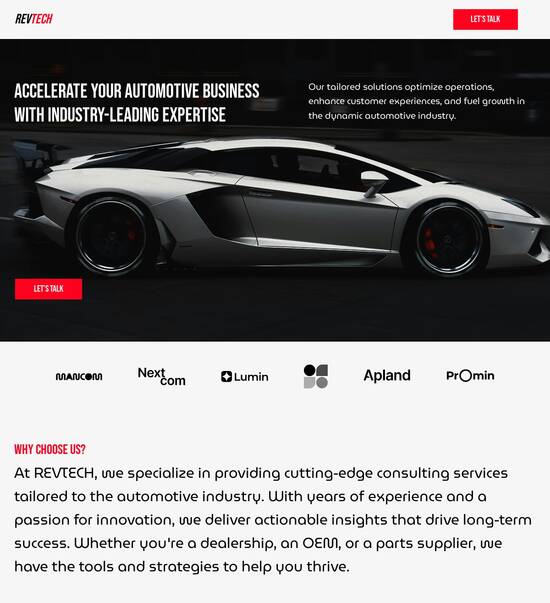
Home page template for agile teams
Explore Similar TemplatesAbout template
Just pick the right home page template for agile teams and customize it on the spot. See more to streamline your marketing performance.
Recommended templates

Easy to build without coding
With the intuitive drag-and-drop builder, anyone on your team can create high-converting pages without any knowledge of code or design. Make enhancements to your landing page with custom widgets using Javascript, HTML/CSS, or third-party scripts.

Multiple layouts for any industry and goal
Select from 500+ landing page layouts built to boost conversions across industry-specific scenarios. Customize them by adjusting fonts, adding images, and generating on-brand content with the AI assistant. Quickly scale with Instablocks® and Global Blocks that you can save, reuse, and update globally.

Loads fast and looks polished on any device
Every template is responsive, which means they present professionally on any device and load blazingly fast with our Thor Render Engine. You can also power them up with Google AMP technology to deliver an unparalleled mobile experience and drive higher conversions.

Robust analytics & experimentation
Get real-time updates and reporting across all your devices, showing the number of visitors, conversions, cost-per-visitor, and cost-per-lead. Launch AI-powered experiments, run A/B tests, and use heatmaps to analyze user behavior, then optimize your landing page to maximize conversions.







Easy to build without coding
With the intuitive drag-and-drop builder, anyone on your team can create high-converting pages without any knowledge of code or design. Make enhancements to your landing page with custom widgets using Javascript, HTML/CSS, or third-party scripts.
Multiple layouts for any industry and goal
Select from 500+ landing page layouts built to boost conversions across industry-specific scenarios. Customize them by adjusting fonts, adding images, and generating on-brand content with the AI assistant. Quickly scale with Instablocks® and Global Blocks that you can save, reuse, and update globally.
Loads fast and looks polished on any device
Every template is responsive, which means they present professionally on any device and load blazingly fast with our Thor Render Engine.
Robust analytics & experimentation
Get real-time updates and reporting across all your devices, showing the number of visitors, conversions, cost-per-visitor, and cost-per-lead. Launch AI-powered experiments, run A/B tests, and use heatmaps to analyze user behavior, then optimize your landing page to maximize conversions.
All the features you need to build lead-generating landing pages
Explore more featuresLearn how to build top-performing landing pages for any goal
FAQs
Leading the way in building high-performing landing pages





A step-by-step guide to using Instapage for effective landing page creation
Creating effective landing pages is crucial for maximizing your digital marketing ROI. Instapage offers an all-in-one platform that allows marketers to accelerate their campaigns through powerful landing page and conversion rate optimization (CRO) tools. Whether you're working in business services, tech/SaaS, or education sectors, this guide will walk you through the essential steps to harness the full potential of Instapage.
Understanding landing page fundamentals
Landing pages serve as the focal point for your marketing campaigns. They must be designed to drive conversions, whether it's generating leads, increasing sign-ups, or driving sales. Key elements of a successful landing page include concise messaging, compelling visuals, and clearly defined calls-to-action (CTAs). Instapage simplifies this process with its user-friendly interface, allowing you to create pages without the need for coding.
- Focus on a single conversion goal to avoid distractions.
- Utilize high-quality images and videos to capture attention.
- Ensure your CTAs stand out and are persuasive.
Choosing the right template
Instapage provides over 100 high-converting templates tailored for various industries. Selecting a template that aligns with your campaign goals is vital. You can customize these templates to match your branding, ensuring a cohesive user experience.
- Select a template based on your conversion objective.
- Personalize your template with brand colors and fonts.
- Keep layouts simple to enhance speed and user engagement.
Leveraging optimization features
Once your landing page is live, it's time to optimize for performance. Instapage's built-in experimentation tools, such as A/B testing and heatmaps, allow you to analyze user behavior and make data-driven decisions.
- Run A/B tests on various elements like headlines and images for optimal performance.
- Use heatmaps to identify areas where users click most.
- Review analytics dashboards to track conversions and adjust accordingly.
Implementing these steps will help you create high-performing landing pages that resonate with your audience.
To get started on experiencing the full potential of your marketing campaigns, sign up for Instapage today and take advantage of our comprehensive tools for landing page creation and optimization.
People also ask about Home page template for agile teams
Unveiling the home page template for agile teams
Understanding the agile framework
Agile is a well-established methodology that allows teams to respond dynamically to evolving project requirements. At its core, the agile framework promotes flexibility and adaptability, enabling teams to pivot quickly in response to feedback and changing needs. Unlike traditional methodologies that often adhere to rigid, sequential stages, agile embraces an iterative approach, allowing teams to refine their products incrementally. This not only fosters innovation but also encourages a mindset geared toward continuous improvement.
Collaboration is another hallmark of agile practices. Cross-functional teams work closely with stakeholders to ensure that the project aligns with user expectations and business goals. This collaborative environment often leads to enhanced communication and better integration of diverse perspectives. By breaking down silos between departments, agile teams can tackle challenges more effectively and produce high-quality outcomes.
Emphasis on flexibility and adaptability
Collaboration across teams and stakeholders
Incremental delivery and continuous improvement
The role of templates in agile workflows
In the agile context, templates play a crucial role in streamlining workflows. While standards help maintain uniformity, the best agile templates offer flexibility, allowing teams to customize them based on their unique requirements. This equilibrium between standardization and customization helps reduce time-to-market — a critical factor in competitive industries. By leveraging pre-built solutions, teams can quickly set up operations without having to reinvent the wheel each time.
Templates can also facilitate best practices by encapsulating effective strategies and proven methodologies within a structured format. This enables teams to focus on execution rather than foundational setup, thereby accelerating the delivery of projects and enhancing overall agility.
The anatomy of an agile team template
An effective home page template for agile teams is built on a user-friendly design that promotes collaboration. The layout must be intuitive, ensuring that all team members can navigate it effortlessly. Modular structures enable easy updates and enhancements, reflecting the project's evolving nature. In addition to usability, a responsive layout is key to ensuring that team members can access vital information seamlessly across devices, whether on desktops or mobile applications.
Key features of an agile home page template include built-in task tracking and prioritization components. These functionalities help teams identify critical tasks and allocate resources effectively. Moreover, integration with popular communication tools, such as Slack and Microsoft Teams, fosters real-time collaboration and keeps the entire team aligned. Customizable sections allow for specific project onboarding, detailing essential updates and statuses to keep every member informed.
User-friendly design tailored for collaboration
Modular structure for easy updates and additions
Responsive layout for seamless cross-device performance
Built-in task tracking and prioritization components
Integration with communication tools (Slack, Microsoft Teams)
Customizable sections for project onboarding and status updates
Technical underpinnings: Events in action
Understanding the technical aspects of a home page template can significantly enhance the user experience. Utilizing `document.addeventlistener` is a fundamental part of web development, allowing developers to create event-driven applications. This JavaScript method lets developers register specific functions to respond to various events, making the web page interactive and ensuring the template behaves as intended.
For instance, common events like clicking a button to mark a task as complete can trigger updates in the project status. Such interactions enhance user engagement and ensure that team members can easily keep track of ongoing projects. By incorporating `document.addeventlistener`, the template becomes more than just a static page; it turns into a dynamic workspace.
`document.addeventlistener` enhances user interaction with templates
Common events connected to agile functionalities (e.g., status updates, task completions)
Optimizing user experience with `DOMContentLoaded`
`DOMContentLoaded` is crucial for performance optimization, as it indicates when the initial HTML document has been completely loaded and parsed. By implementing this event, teams can ensure that vital elements of the template are accessible and ready for interaction soon after loading. This reduces wait times and improves the overall user experience, allowing team members to begin their work quickly.
Best practices involve employing `DOMContentLoaded` to encapsulate scripts that depend on DOM elements. For agile teams, this means ensuring that tools such as task boards and documentation links are interactive right away, allowing for a more fluid workflow that capitalizes on the requisite speed and efficiency.
Customization and personalization
One of the vital aspects of a home page template for agile teams is its ability to be tailored to meet specific organizational needs. Customizing design elements while preserving core functionalities helps maintain the integrity of the agile approach. Teams should consider guidelines that foster adaptability, such as retaining the main layout while altering sections like task boards, reporting tools, or communication channels.
Examples of customizable fields include project categories, statuses, and responsibilities assigned to team members. By making room for personalization, the template becomes more engaging, contributing to enhanced accountability and motivation across the team.
Guidelines for adapting design elements without disrupting core functionalities
Examples of customizable fields and sections
Integrating feedback loops
Incorporating feedback loops into the template is fundamental for continuous observation and enhancement. By embedding user feedback mechanisms, teams can gather insights on template performance and areas for improvement. Encouraging team members to provide feedback, whether through forms or discussions, creates a culture of openness and collaboration, where everyone feels they have a voice.
This information is invaluable during agile team retrospectives, as it can guide meaningful changes to the template and ensure that it meets evolving needs. Teams can implement real-time adaptation strategies to address concerns promptly, making the template a living document that grows with the team.
Enhancing collaboration through centralization
The home page serves as a central hub for team interaction, making it critical for effective collaboration. A well-designed home page contributes to transparency and encourages open communication among team members. By featuring links to essential resources, project documentation, and communication channels, the home page firmly establishes a go-to location for everything related to the project.
Features such as embedded collaborative documents, like Google Docs or Notion pages, enable real-time co-authoring and enhance synergy among team members. This centralization minimizes the likelihood of miscommunication and ensures everyone is on the same page, quite literally.
The importance of a centralized home page for fostering collaboration
Features that facilitate team communication and transparency
Tools for embedding collaborative documents (Google Docs, Notion)
Leveraging analytics for team performance
Integrating built-in analytics into the home page template can be a game changer for tracking team effectiveness and project progress. By monitoring key performance indicators, teams can interpret data to inform critical decisions regarding resource allocation and workflow adjustments. Observing metrics like task completion rates, sprint velocity, and backlog health can help ensure that teams stay aligned with agile best practices.
Moreover, leveraging analytics can illuminate areas for improvement and foster a culture of accountability. By utilizing concrete data, teams can make informed decisions and foster an environment where productivity becomes quantifiable and visible to everyone involved.
Case studies: Real-world applications
Examining industry examples can reveal how agile teams have successfully utilized home page templates to optimize their workflows. For instance, Company A integrated a customizable home page that allowed real-time tracking of ongoing projects. This resulted in a 30% increase in project completion rates and significantly enhanced team morale, as everyone felt informed and engaged with their tasks.
In another example, Company B used a template that fostered better communication through integrated chat tools and shared documents. This led to faster decision-making, as team members were able to interact and collaborate effectively in real time. Testimonials from team leaders underscore the transformative impact such templates have had on efficiency and productivity.
Future trends and innovations in template design
As agile practices continue to evolve, home page templates are likely to adapt in response. Predictions indicate that the integration of AI and automation can significantly augment template functionalities. Automated reporting systems and task assignments may soon play a prominent role, allowing teams to focus on strategic decision-making rather than cumbersome administrative tasks.
Furthermore, new web technologies will continue to shape the landscape of template adaptability. Progressive web apps (PWAs) present exciting opportunities for agile teams, combining the best of web and app functionalities. These innovations can enhance user experience and provide teams with the tools needed to remain agile in a rapidly changing environment.
Predictions on the evolution of agile methodologies and their impact on template design
How AI and automation could shape template functionalities
Impact of new web technologies on template adaptability
Creating a lasting impact with effective template use
Successfully implementing a home page template into existing workflows hinges on several key factors. First, teams must engage in comprehensive planning to outline the necessary features and functions before rolling out the template. This ensures that the team remains aligned with the agile principles of incremental delivery and collaboration. Training sessions for team members can also aid in overcoming any learning curve associated with adopting new tools.
Additionally, it's essential to stay vigilant about common pitfalls. Over-customization can lead to integration complexities, straying too far from the core template functionalities. Ensuring that the home page template aligns with the team's objectives will solidify its effectiveness and relevance.
Steps for smooth integration of the home page template into existing workflows
Common pitfalls to avoid when personalizing the template for agile teams
Long-term benefits of using home page templates
The long-term benefits of implementing home page templates for agile teams are numerous. By sustaining flexibility and responsiveness, teams foster an environment that encourages innovation and adaptation to changes. Templates can provide the structure needed to navigate unexpected shifts in projects while allowing team dynamics to thrive.
Ultimately, an effective home page template turns the foundation of processes into an adaptability asset, helping teams not only keep pace but prosper in a fast-paced business world.
Emotional engagement: Inspiring agile teams through design
When it comes to work culture, thoughtful template design can foster an atmosphere ripe for creativity and innovation. By crafting visually appealing templates, organizations signal that they value their team members and their contributions. Engaging design choices can spark enthusiasm and motivation, encouraging team members to take ownership of their roles and responsibilities.
Moreover, a focus on team cohesion can be embedded within the design. Features that promote community-building, such as social feeds or peer recognition areas, can enhance team spirit and make the workplace feel more connected. When team members feel appreciated and engaged, they’re likely to be more productive and satisfied in their roles.
Craft an atmosphere of creativity and innovation through design choices
Encourage engagement and ownership among team members through positive UI experiences
Importance of visual design elements in enhancing team spirit
Ready to skyrocket conversions?
Supercharge your ad campaigns with high-performing landing pages
Get started














